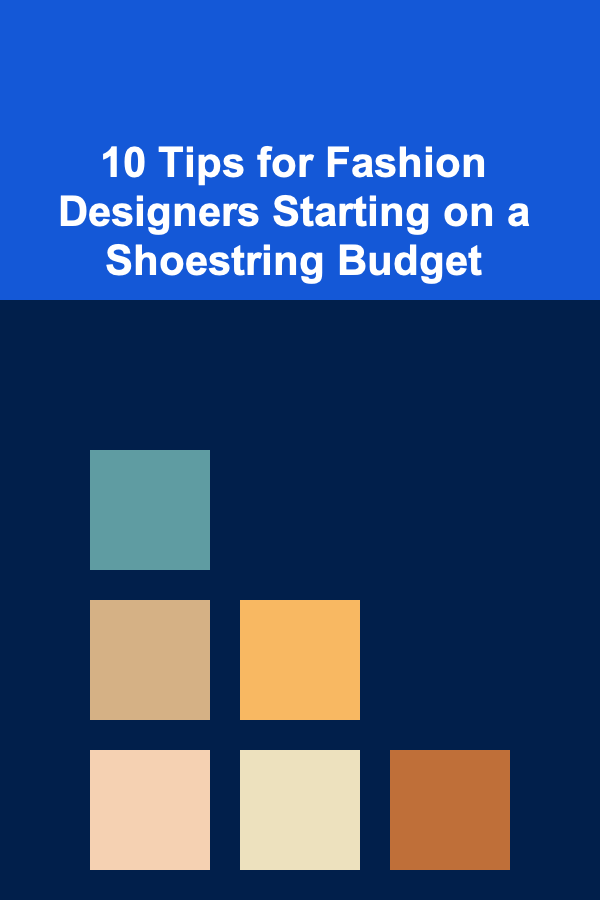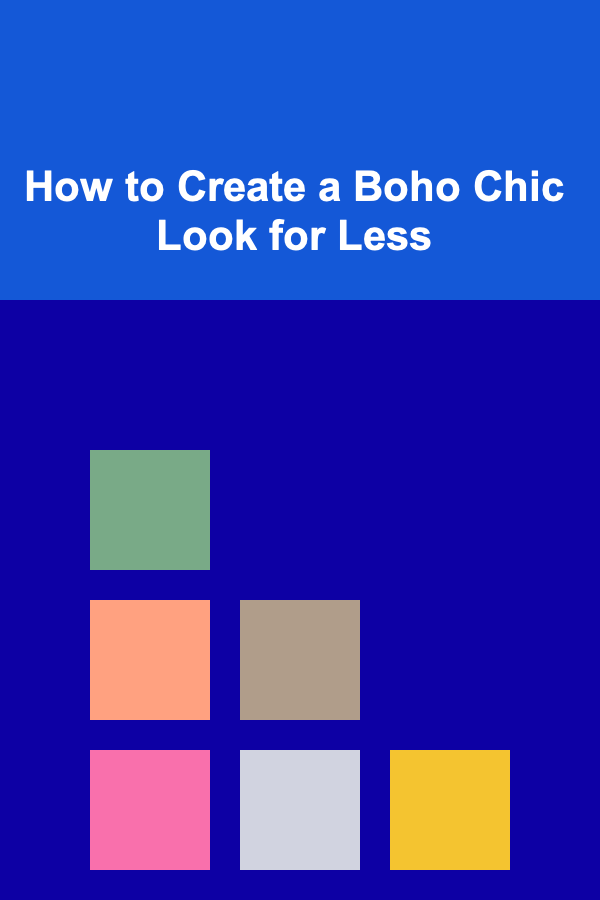
10 Tips for Fashion Designers Starting on a Shoestring Budget
ebook include PDF & Audio bundle (Micro Guide)
$12.99$8.99
Limited Time Offer! Order within the next:

Starting a career in fashion design can seem like a daunting task, especially when working with limited resources. However, many successful designers began their journeys with little more than talent, passion, and a shoestring budget. In today's world, with creativity and strategic thinking, it is possible to launch a fashion business or establish yourself as a designer without needing vast financial backing. This article will provide 10 tips to help you navigate the fashion industry on a budget and set yourself up for success.
Leverage Your Network and Relationships
Networking is a crucial aspect of building any business, and the fashion industry is no exception. When starting with limited financial resources, your relationships can be one of your greatest assets. Connect with other aspiring designers, stylists, photographers, and influencers who are also starting out. Collaborating with others can provide you with mutual benefits such as:
- Shared resources like equipment or space
- Free marketing through social media exposure
- Access to a broader audience
Attending industry events, workshops, and trade shows is another great way to meet key players in the fashion world. Although these events might come with a fee, you can often find free or low-cost alternatives such as networking nights, online forums, and fashion meetups. Additionally, don't overlook the power of social media, particularly platforms like Instagram and LinkedIn, where you can easily connect with fellow designers and potential clients.
Start Small and Scale Up
When you're on a budget, starting small is essential. It's tempting to dream big and aim for a full-fledged fashion line right out of the gate, but it's often more sustainable and practical to start with a limited number of designs. Focus on creating a few key pieces that showcase your style and skill, whether that's a capsule collection or a small batch of custom-made garments.
Starting small allows you to:
- Focus your energy and resources on a specific vision
- Test the market with limited production to gauge customer interest
- Build a solid foundation for your brand before expanding
Once your pieces gain traction and you start receiving feedback, you can scale up by introducing more designs and expanding your product range.
Use Affordable Fabric Sources
Fabric is often one of the largest expenses for any fashion designer. While high-end fabrics can be expensive, there are many affordable alternatives that can still create beautiful garments. Search for fabric sales, outlet stores, or even repurpose old clothes and textiles. Thrift stores and online marketplaces (e.g., eBay, Etsy, or Facebook Marketplace) can be a goldmine for vintage fabrics and materials.
Some affordable fabric sourcing ideas include:
- Local fabric wholesalers that offer bulk discounts
- Off-season fabric sales
- Buying remnants or surplus fabrics at discounted prices
- Using fabric samples or small quantities to test out designs
By focusing on budget-friendly fabric options, you can create beautiful, one-of-a-kind designs without overspending.
Learn to Sew and Make Patterns Yourself
Although many designers start by hiring seamstresses or pattern makers, doing this on a budget may not always be feasible. Learning to sew and create your own patterns can save you a significant amount of money, especially in the early stages of your career. There are many online resources, YouTube tutorials, and courses that can teach you basic sewing techniques, pattern-making, and garment construction.
By mastering these skills, you'll be able to:
- Produce garments at a fraction of the cost of hiring someone else
- Have full creative control over your designs
- Experiment with various styles and techniques without external constraints
Even if you don't become a professional seamstress, gaining basic sewing skills can be a game-changer for a designer on a budget.
Make Use of Technology
In today's digital age, technology can significantly lower the costs of running a fashion design business. Software tools and online platforms can help you streamline processes like sketching, pattern making, and marketing without the need for expensive equipment. Some affordable tools to consider include:
- Adobe Illustrator or Inkscape for creating digital fashion sketches and designs
- CLO 3D or TUKAcad for virtual garment fitting and pattern making
- Canva or Adobe Spark for creating marketing materials and social media graphics
You can also use e-commerce platforms like Shopify or Etsy to sell your designs online. These platforms typically offer low setup fees and have built-in marketing tools, allowing you to reach customers globally without needing a physical storefront.
Crowdfund Your Fashion Line
If you're struggling to fund the initial stages of your fashion business, consider crowdfunding as a way to gather capital. Platforms like Kickstarter, GoFundMe, and Indiegogo allow you to present your ideas to the public and seek financial support. This not only provides you with the funds to bring your designs to life but also builds awareness and support for your brand.
To successfully crowdfund your fashion line, keep these tips in mind:
- Create a compelling, professional campaign that showcases your designs and vision
- Offer unique rewards for backers, such as limited-edition pieces or early access to collections
- Build a strong social media presence to gain attention and credibility
- Be transparent with your backers about the project's timeline and any challenges you face
Crowdfunding is a great way to test the demand for your designs while raising the necessary funds for production.
Focus on Sustainable and Ethical Fashion
Consumers are becoming increasingly conscious of the environmental and ethical impact of their fashion purchases. By focusing on sustainable and ethical practices, you can attract a loyal customer base who values your commitment to the planet and its people.
Here are some sustainable practices to consider:
- Use eco-friendly fabrics like organic cotton, hemp, or recycled materials
- Opt for low-waste design techniques, such as zero-waste pattern making
- Collaborate with ethical manufacturers or produce garments in small quantities to reduce overproduction
By aligning your brand with sustainable values, you not only reduce costs but also cater to a growing segment of the market that prioritizes ethical fashion.
DIY Marketing with Social Media
In the fashion industry, visibility is key. Social media platforms like Instagram, Pinterest, Facebook, and TikTok are invaluable tools for promoting your designs and building an audience without the need for a significant marketing budget. Focus on creating high-quality content, engaging with your followers, and using hashtags that attract the right audience.
Tips for social media marketing on a budget:
- Post consistently: Share your design process, behind-the-scenes footage, and finished products regularly
- Engage with followers: Respond to comments, ask questions, and create polls or interactive posts
- Collaborate with influencers: Work with micro-influencers who may be willing to promote your brand in exchange for free products
- Utilize user-generated content: Encourage your customers to share photos of themselves wearing your designs and repost them on your channels
Social media marketing can be incredibly effective when done thoughtfully and consistently, even on a shoestring budget.
Focus on Niche Markets
Instead of trying to appeal to a broad audience, consider focusing on a specific niche market. By narrowing your target demographic, you can tailor your designs to meet the needs of a particular group, which helps you stand out in a competitive market.
Some niche markets to explore include:
- Plus-size fashion
- Maternity wear
- Sustainable fashion
- Streetwear or urban fashion
- Petite or tall fashion
- Vintage or retro-inspired clothing
By specializing in a niche, you can develop a unique brand identity and connect more deeply with your target customers, making it easier to gain traction without a large budget.
Keep Your Overhead Low
When working on a budget, it's crucial to minimize your overhead costs. Start by working from home or using shared workspaces, rather than leasing an expensive studio or office. When you need equipment, look for second-hand options or rent rather than buying new.
Additionally, focus on building an efficient production process that reduces waste, cuts down on unnecessary expenses, and maximizes your available resources. This includes keeping a close eye on your material usage, optimizing your workflow, and using technology to streamline operations.
By maintaining low overhead and using available resources creatively, you can ensure that your budget goes further.
Starting as a fashion designer with limited funds can be challenging, but it is certainly not impossible. By being resourceful, utilizing modern tools, and focusing on creativity, you can build a successful brand on a shoestring budget. Remember, many of the most iconic designers began their careers with minimal financial backing---what matters most is your passion, dedication, and ability to adapt to the ever-changing fashion industry.
Reading More From Our Other Websites
- [Mindful Eating Tip 101] From Cravings to Conscious Choices: A Practical Mindful Eating Checklist
- [Organization Tip 101] How to Organize Your Photography Equipment at Home
- [Home Budget 101] How to Create a Meal Planning Budget to Save on Groceries
- [Stamp Making Tip 101] Creative Stamp-Making Techniques to Elevate Your Handmade Greeting Cards
- [Beachcombing Tip 101] Shell Hunting 101: Tips for Finding and Identifying Ultra‑Rare Sea Shells
- [Organization Tip 101] How to Create a Home Office That Inspires Productivity
- [Home Budget Decorating 101] How to Create a Cozy Space on a Budget in Your Bedroom for Better Sleep
- [Biking 101] Bike Stem Explained: What It Does and Why It's Important
- [Gardening 101] Kitchen Garden Hacks: How to Maximize Your Harvest in Limited Space
- [Personal Investment 101] Earning Money with AI: How to Make Passive Income with Deep Learning

How to Create a Boho Chic Look for Less
Read More
How to Make Money Online as a Patient Advocate? 10 Actionable Ideas
Read More
How to Maximize Your Tax Refund Each Year
Read More
How to Set Up a Party Buffet That Will Impress Your Guests
Read More
How to Understand the Importance of Word Choice
Read More
How to Choose the Right Moisturizer for Your Climate
Read MoreOther Products

How to Create a Boho Chic Look for Less
Read More
How to Make Money Online as a Patient Advocate? 10 Actionable Ideas
Read More
How to Maximize Your Tax Refund Each Year
Read More
How to Set Up a Party Buffet That Will Impress Your Guests
Read More
How to Understand the Importance of Word Choice
Read More